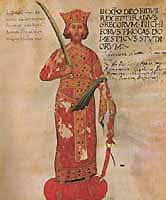
Late Byzantine
Period in Cyprus: AD 965-1191
Emperor
Nicephorus II Phocas of Byzantium, having conquered the coast of
Cilicia and defeated the Egyptian fleet, was able to reoccupy
Cyprus peacefully in AD965. In order to secure the island
against the Saracen threat, the Muslim inhabitants of the island
were encouraged to convert or emigrate.

Nicephorus II Phocas
Emperor, 963-969
A series of
mountain fortresses above the northern coast of the island were
built to give early warning of raiders to the permanent
garrison. Secure inland headquarters were also created with the
foundation of Nicosia, where three high officials set up their
rival courts.
The Byzantine
rule in Cyprus was rigidly thorough in its tax collection but it
also gave back to the people in firm government and in its
building programmes. The 10th century churches of St Lazarus in
Larnaca and St Barnabas near Salamis are some of the most
important Orthodox buildings built during Byzantine period on
the island.
However,
despite the growing prosperity of the island with the increased
trade during the First Crusade, by mid 12th century Byzantine
Empire started showing decline in its military strength. In
about 1184, the Byzantine governor of Cyprus Isaac Comnesus,
rebelled and proclaimed himself emperor.
Isaac resisted
attacks from the Byzantine emperors Andronicus I Comnesus and
Isaac II Angelus, but in 1192, on engaging in hostilities with
an English crusader fleet under King Richard I the Lionheart, he
was defeated and imprisoned. The island was seized by
Richard I (the Lionheart), from whom it was
acquired by the crusading order of the Knights Templar; because
they were unable to pay his price he took it back and sold it to
Guy de Lusignan, the
dispossessed king of Jerusalem.
References
